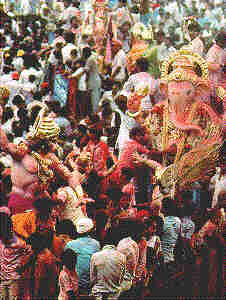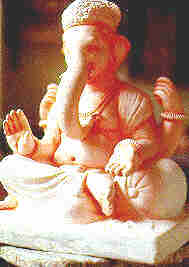Ganesh Chaturthi
By Shri Sudheer Birodkar
Ganesha Chaturthi is a major festival devoted to Lord Ganesh, the elephant-headed God. He is widely known as the remover of obstacles and the Lord of beginnings. This festival is celebrated around August is also called Ganeshotsava.
During the festival, clay idols of Ganesha are specially prepared and most families install a Ganesha murty for two to eleven days. During this time, prayers (Aarti) are performed and hymns are sung every morning and evening. The hymns are sung to the clanging of small gongs (called jhanja), the sounds of which reverberate throughout the day.
The Visarjan (immersion) Processions and Ceremony[edit]
The festival ends with an immersion ceremony of immersion where the murty is immersed in the sea, river or well. The ceremony, called Ganesha-Visarjan (immersion of Ganesha), is as popular as the actual multi-day festival. Huge crowds move in a procession, with each family carrying their murty towards the places of immersion. These processions begin in the afternoon and continue till the late hours of the night.
Although this festival is observed in all parts of the world, it is celebrated with maximum fervor in the state of Maharashtra, in modern India, where it is celebrated both publicly and privately. Apart from the small idols of Ganesha installed in various houses, there are also many public celebrations called Sarvajanik Ganeshotsava.
Public celebration of Ganesh Chaturthi started by Lokmanya Tilak[edit]
The public celebration of Ganesh Chaturthi was started by Lokmanya Tilak[1] during the early parts of the Indian freedom movement (vs the British).
In these public celebrations, huge murtys of Ganesha, ranging from 10 feet to 40 feet, are installed. Like the Ganesha murtys at home, these murtys also receive daily prayers and hymns. In addition, large entertainment programs are also organized to entertain both the murty as well as the public at large--attracting large crowds and increasing the devotional fervor of the people.
Origin of Ganesha[edit]
The purana's explain that Ganasha, also known as Gajanana or Vinayaka is no ordinary Deva, but is the first among equals. All prayers start with the invocation "Shree Ganeshaaya Namaha" meaning "Salutations to You O Ganesha".
Parvati makes Ganesha from Clay and Infuses Life in the Idol[edit]
According to the Puranas, the divine couple of Shiva and Parvati had remained childless for a long time. Parvati's motherly instincts made her yearn for a son and Shiva's long absence from home intensified her yearning. On day, she decided to mold a statue of clay in the form of a son. She used her divine power to bring the clay idol to life to satisfy her yearning. Happy as she was to have the company of a son, she went about her chores, many a times leaving the boy in charge of the house.
Shiva Confronts Ganesha[edit]
One fine day while Parvati was busy with her daily ablutions, Shiva came home and saw Parvati's son Ganesha, guarding the entrance to his house.
Strangers as they were to each other, Ganesha, refused allow Shiva to enter the house. Taken aback at being prevented from entering his own house, Shiva asked this tiny sentinel who he was. On being told that he was Parvati's son, Shiva was confounded and Shiva chopped off his head and threw it away in a fit of anger.
Shiva fetches an Elephant's Head for the Beheaded Ganesha[edit]
When Parvati heard about this outrage she lost her temper and demanded that Shiva restore her son to life immediately. Compelled to appease Parvati, Shiva set out to find the head of her son. Hard as he tried, he could not find the head that he had chopped off and thrown away in disgust. As he could not find the head he wanted, he thought of fitting the headless body with the head of any living being that he would come across where the mother was sleeping with her back to her child. He came across a baby elephant and true to his word, Shiva chopped off the elephant's head, fitted it to the lifeless body and revived him. This was how the Lord Gajanana or Gaja-Mukha came into being.
Ganesha become the first among the Gods[edit]
To atone for his deed, Shiva also granted a special status to Gajanana by issuing a divine decree that thence forth Gajanana would be the first to be invoked in every prayer and only after this, could the invocation of any prayer takes place. In deference to the decree of lord Shiva, Ganesha continued to be regarded as the first God to be invoked in any prayer.
References[edit]
- Sudheer Birodkar, "A Hindu History: A Search for our Present History". Reprinted with permission.


